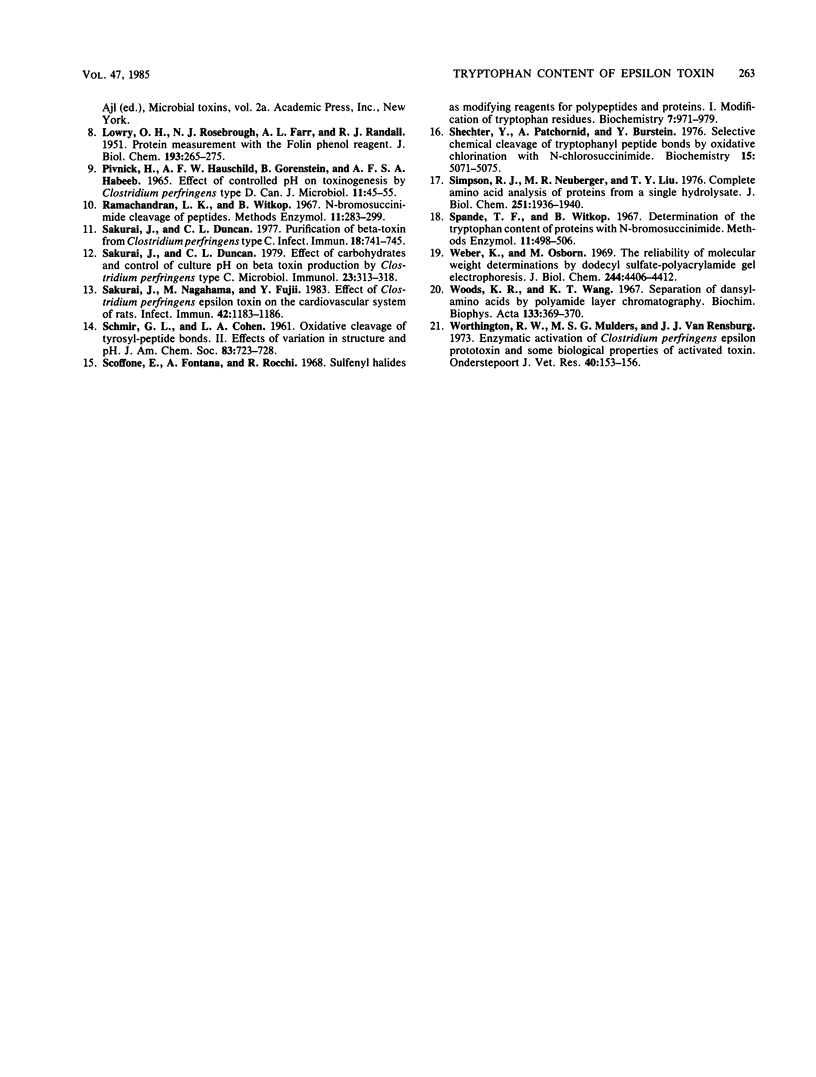Abstract
The tryptophan content of Clostridium perfringens epsilon toxin was investigated. When the tryptophan content was determined by amino acid analysis after the hydrolysis of epsilon prototoxin with methanesulfonic acid containing 3-(2-aminoethyl)indole and by the spectrophotometric method with N-bromosuccinimide, the number of tryptophan residues was calculated at 1/mol of the protein. Cleavage of the prototoxin or the toxin with N-bromosuccinimide in the presence of urea gave two new fragments on sodium dodecyl sulfate-polyacrylamide gel electrophoresis. There was only a tyrosine residue as the new N-terminal amino acid after the cleavage of the prototoxin or the toxin with N-bromosuccinimide. The data showed that epsilon prototoxin or epsilon toxin contained only one tryptophan residue.
Full text
PDF



Images in this article
Selected References
These references are in PubMed. This may not be the complete list of references from this article.
- Bhown A. S., Habeerb A. F. Structural studies on epsilon-prototoxin of Clostridium perfringens type D. Localization of the site of tryptic scission necessary for activation to epsilon-toxin. Biochem Biophys Res Commun. 1977 Oct 10;78(3):889–896. doi: 10.1016/0006-291x(77)90506-x. [DOI] [PubMed] [Google Scholar]
- Habeeb A. F., Lee C. L., Atassi M. Z. Conformational studies on modified proteins and peptides. VII. Conformation of epsilon-prototoxin and epsilon-toxin from Clostridium perfringens. Conformational changes associated with toxicity. Biochim Biophys Acta. 1973 Oct 18;322(2):245–250. doi: 10.1016/0005-2795(73)90300-0. [DOI] [PubMed] [Google Scholar]
- Habeeb A. F. Studies on epsilon-prototoxin of Clostridium perfringens type D. I. Purification methods: evidence for multiple forms of epsilon-prototoxin. Arch Biochem Biophys. 1969 Mar;130(1):430–440. doi: 10.1016/0003-9861(69)90055-1. [DOI] [PubMed] [Google Scholar]
- Habeeb A. F. Studies on epsilon-prototoxin of Clostridium perfringens type D. Physicochemical and chemical properties of epsilon-prototoxin. Biochim Biophys Acta. 1975 Nov 18;412(1):62–69. doi: 10.1016/0005-2795(75)90339-6. [DOI] [PubMed] [Google Scholar]
- LOWRY O. H., ROSEBROUGH N. J., FARR A. L., RANDALL R. J. Protein measurement with the Folin phenol reagent. J Biol Chem. 1951 Nov;193(1):265–275. [PubMed] [Google Scholar]
- PIVNICK H., HAUSCHILD A. H., GORENSTEIN B., HABEEB A. F. EFFECT OF CONTROLLED PH ON TOXINOGENESIS BY CLOSTRIDIUM PERFRINGENS TYPE D. Can J Microbiol. 1965 Feb;11:45–55. doi: 10.1139/m65-007. [DOI] [PubMed] [Google Scholar]
- Sakurai J., Duncan C. L. Effect of carbohydrates and control of culture pH on beta toxin production by Clostridium perfringens type C. Microbiol Immunol. 1979;23(5):313–318. doi: 10.1111/j.1348-0421.1979.tb00468.x. [DOI] [PMC free article] [PubMed] [Google Scholar]
- Sakurai J., Duncan C. L. Purification of beta-toxin from Clostridium perfringens type C. Infect Immun. 1977 Dec;18(3):741–745. doi: 10.1128/iai.18.3.741-745.1977. [DOI] [PMC free article] [PubMed] [Google Scholar]
- Sakurai J., Nagahama M., Fujii Y. Effect of Clostridium perfringens epsilon toxin on the cardiovascular system of rats. Infect Immun. 1983 Dec;42(3):1183–1186. doi: 10.1128/iai.42.3.1183-1186.1983. [DOI] [PMC free article] [PubMed] [Google Scholar]
- Scoffone E., Fontana A., Rocchi R. Sulfenyl halides as modifying reagents for polypeptides and proteins. I. Modification of tryptophan residues. Biochemistry. 1968 Mar;7(3):971–979. doi: 10.1021/bi00843a014. [DOI] [PubMed] [Google Scholar]
- Shechter Y., Patchornik A., Burstein Y. Selective chemical cleavage of tryptophanyl peptide bonds by oxidative chlorination with N-chlorosuccinimide. Biochemistry. 1976 Nov 16;15(23):5071–5075. doi: 10.1021/bi00668a019. [DOI] [PubMed] [Google Scholar]
- Simpson R. J., Neuberger M. R., Liu T. Y. Complete amino acid analysis of proteins from a single hydrolysate. J Biol Chem. 1976 Apr 10;251(7):1936–1940. [PubMed] [Google Scholar]
- Weber K., Osborn M. The reliability of molecular weight determinations by dodecyl sulfate-polyacrylamide gel electrophoresis. J Biol Chem. 1969 Aug 25;244(16):4406–4412. [PubMed] [Google Scholar]
- Woods K. R., Wang K. T. Separation of dansyl-amino acids by polyamide layer chromatography. Biochim Biophys Acta. 1967 Feb 21;133(2):369–370. doi: 10.1016/0005-2795(67)90078-5. [DOI] [PubMed] [Google Scholar]



